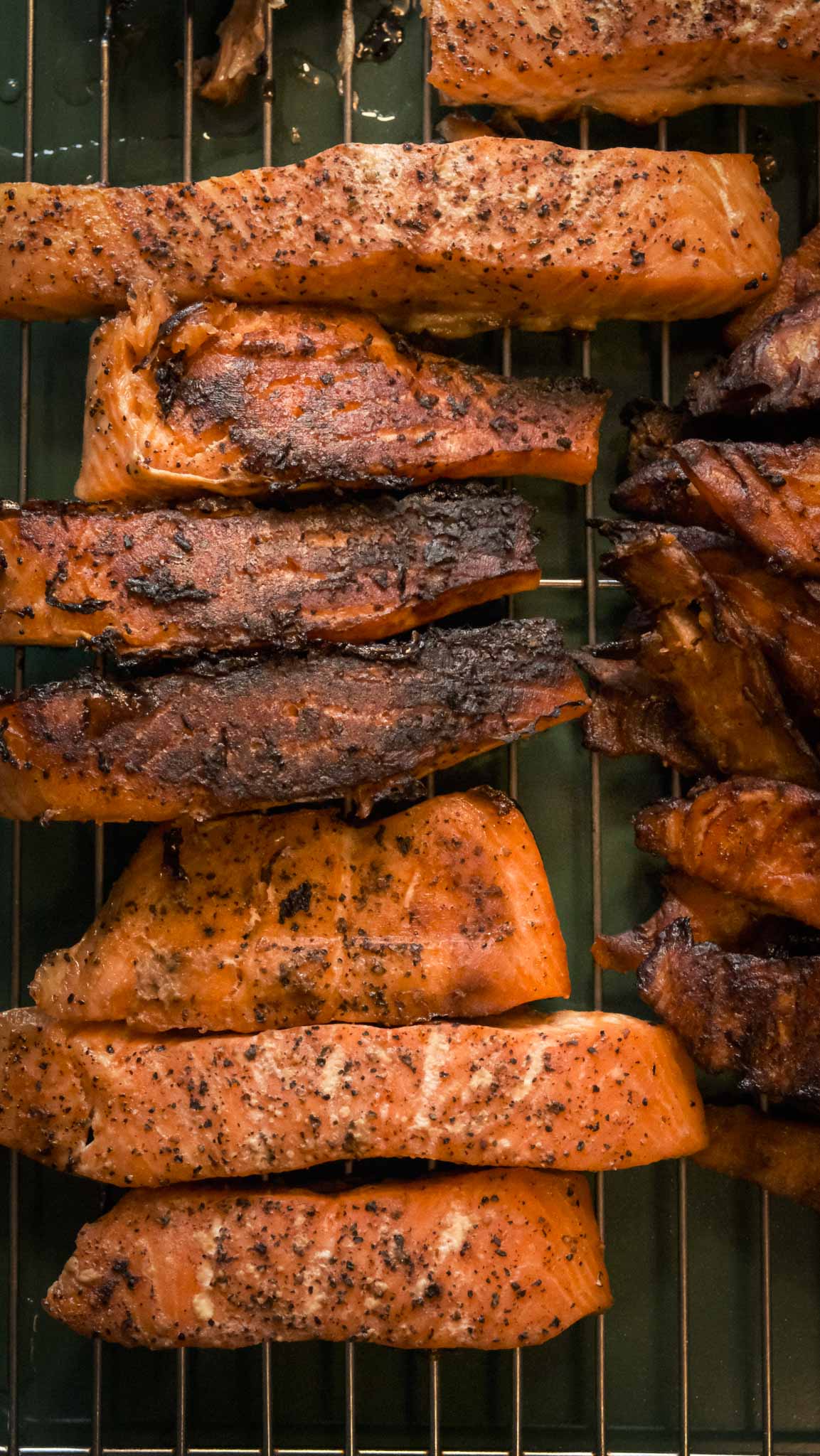
This post may contain affiliate links. See my full disclosure HERE.
Jump to RecipeThe best smoked salmon recipe
This recipe is for how to make hot smoked salmon and outlines all steps from preparations, brining, smoking, and enjoying. It is simple and easy and I don’t believe there is a more rewarding recipe.
Let me start by saying that smoking and salmon belong together like soul mates. There is no better way to enjoy a beautiful piece of salmon than slowly hot smoking it to perfection. The process is simple and a lot of fun. Not only is it well worth it due to the amazingly delicious end product but the whole process connects us to the food and nature. I believe taking care and intention with your food nourishes us in more ways than just physically but also ignites some of our DNA that holds innate remembrance of our primal cooking instincts.
Hot smoked vs cold smoked salmon:
There are two ways to smoke salmon: hot-smoked and cold-smoked. This is a recipe for hot-smoked salmon. During hot-smoking, the salmon is cooked low and slow for a few hours around 180-225°F and cooked through while remaining soft and moist. Cold smoking is smoked around 80°F for a longer amount of time and the salmon remains in its natural state rather than the proteins denaturing in the cooking process. This type is what you will find packaged as very thin slices and is considered an expensive, high-end product. This is the same type of salmon used for the classic Lox bagel breakfast.
The filets produced from this hot smoking recipe are great to eat alone as is or on top of a salad, pasta, eggs(think- eggs Benedict or inside an omelet), or made into a creamy dip.
Enjoy this incredibly simple and delicious recipe: How to make hot smoked salmon. In addition to this recipe, I have included information from nutritional facts, differences between wood species flavor profiles and a compare and contrast of wild salmon vs farmed, Alaskan salmon vs Atlantic salmon.


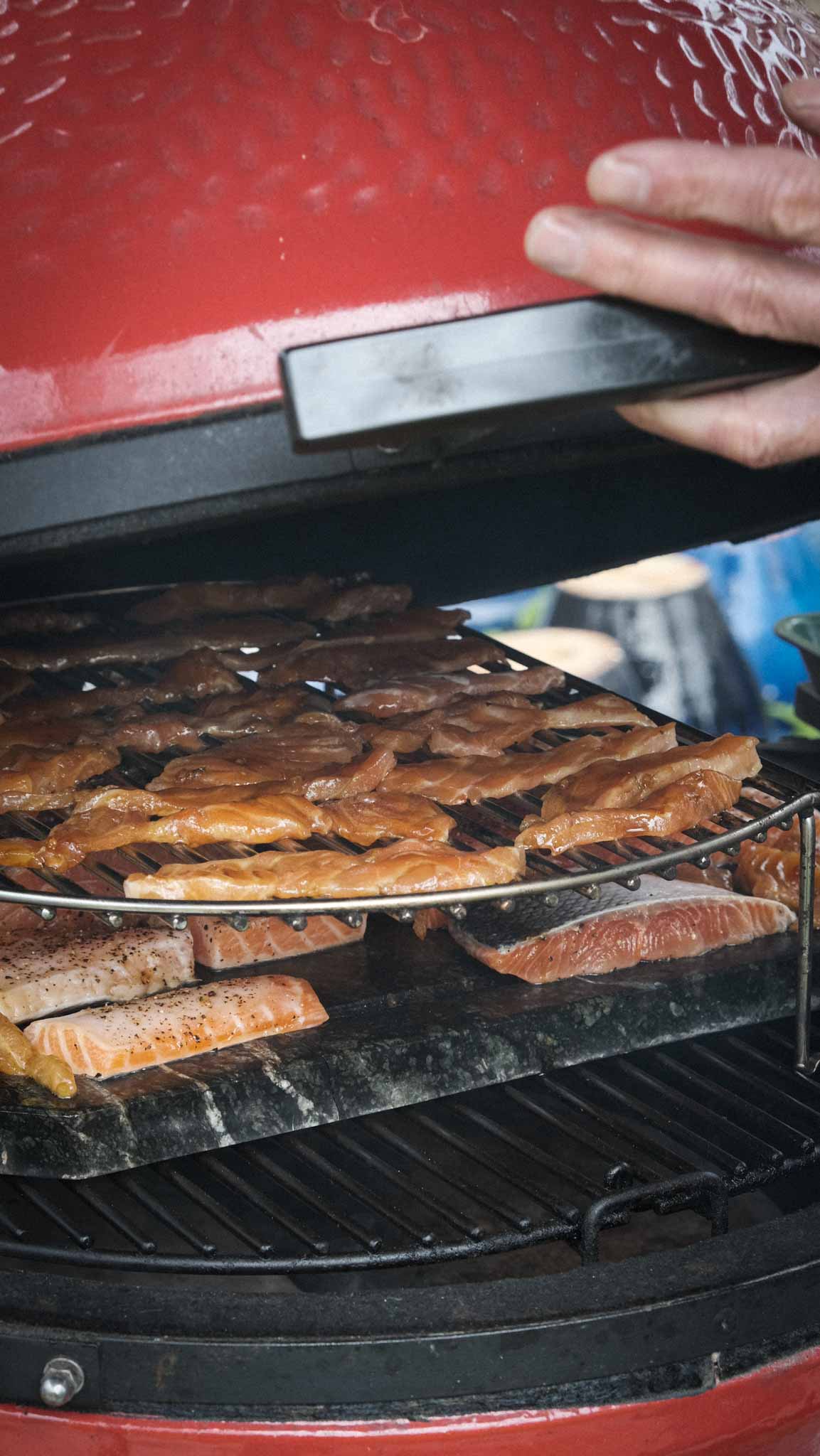
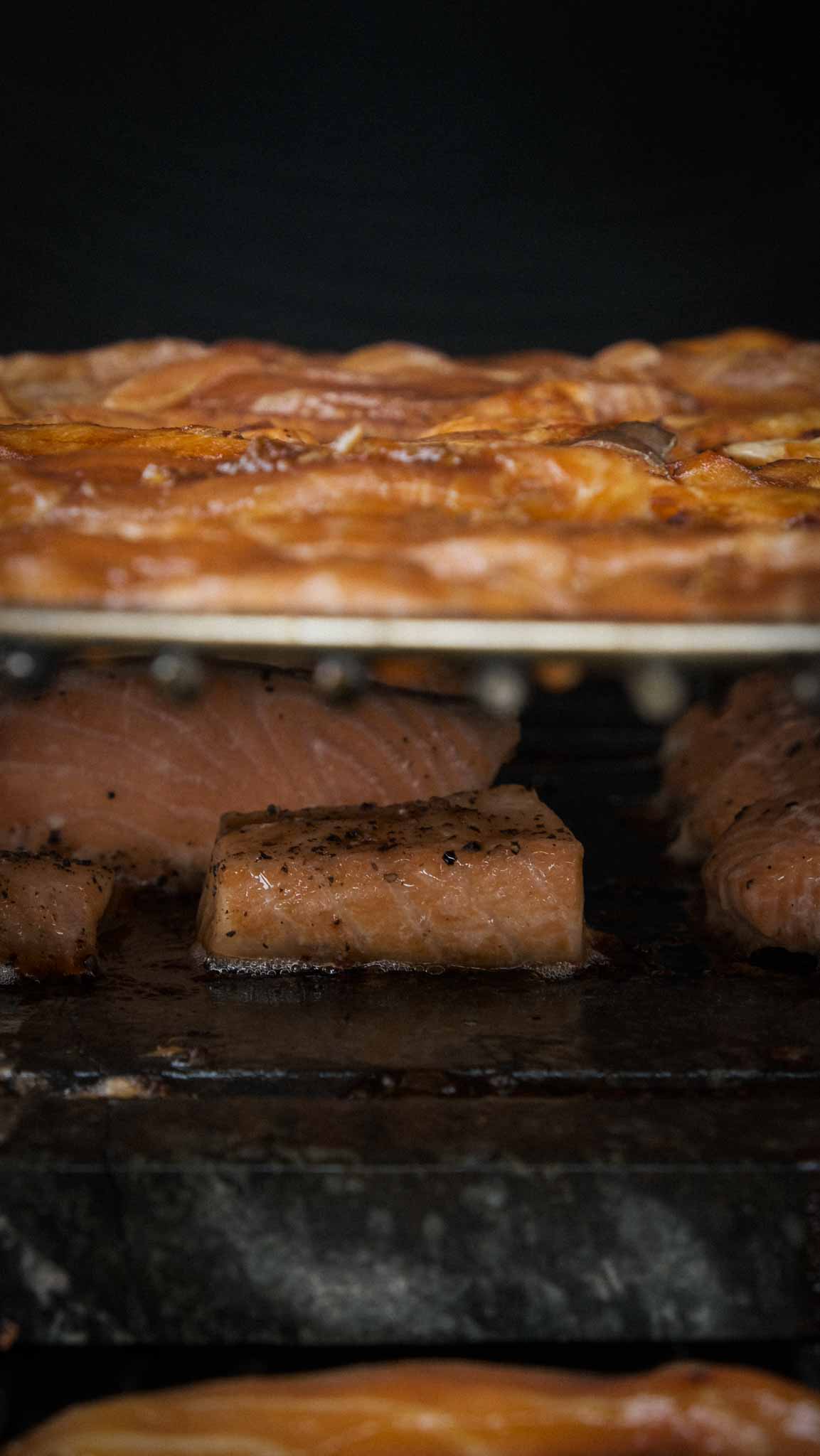
Ingredients:
- Salmon
- Kosher Salt (no added agents such as anti-cracking)
- Brown Sugar
- Charcoal and damp wood chips (hickory, pecan, mesquite, oak, apple, maple, alder)
- Optional: Spice or herb rub. Maple syrup(the real stuff), spicy pepper hot sauce (for basting while cooking)
Equipment:
- Smoker, I used the Kamado Joe Classic
- Tray or platter for collecting and resting when cooked
- Basting brush
Temp: 225° F
Smoking time: 3-4 hours depending on size of filet
Brining time: 12 hours
Instructions:
Forethought: Use as much fish as you would like, I use nearly 4 lbs because it is a long process and I like to get as much out of my time as I can. Keep skin intact on the fish.
- Making the hot smoked salmon brine: Add the brown sugar, kosher salt and water to a pot and boil until everything is completely dissolved. Allow to cool completely. Add the fish and place in the refrigerator for 12 hours.
- Prepare your smoker to 200-225°F with charcoal and dampened wood chips.
- Remove the fish, rinse and pat dry. Add the your smoker skin side down.
- Optional: baste the top of the fish throughout the cooking process with maple syrup or spicy pepper sauce or a mixture of both.
- Remove when the internal temperature has reached approximately 140°F. If you don’t have an internal temperature reading you can always break open the center of one fillet to check it around 3 hours and sample it to tell if it is done.
*In the photos you will see that along with filets, I made salmon jerky. The only differences for jerky were cutting into thin slices and removing them from the smoker when they reached my desired jerky doneness.
Notes:
-Kosher salt with no additives. Table salt that has agents like anti-cracking additives can give an off-taste to the food.
-I use charcoal to smoke this salmon because it allows for cooking at lower temperatures which means the fish can smoke for longer and soak up more smoky flavor. This also ensures not over-cooking the fish. Wood burns hotter and faster, needs to be fueled constantly and because of these facts the temperatures fluctuates. Whereas charcoal goes slow and long for a long time, this keeps a consistent temperature.
-Soak or dampen wood chips and add them for unique flavor and more fresh wood smoke flavor.
-Leave the skin on because this helps keep the fish intact and moist. The skin will get crispy and the meat will easily depart from the skin for eating.
-Skin side down will allow for crispy skin and a soft, moist, flaky top. Presentation side down(meat side) will create a crispy top. You can notice in my photos that I did both ways to get a different outcome and experience. The ones that were presentation side down were basted with maple syrup then placed downward to create a caramelized crispy top.
-This recipe uses a wet brine: salt and brown sugar dissolved in water. You can use a dry rub instead which you would just mix the salt and sugar until combined and then dry rub it directly on to the meat side of the fish. With either brine method, don’t forget to rinse the fish off and then pat dry it before cooking.
-How long to brine salmon for smoking: The typical range is 8-12 hours but a bare minimum amount of time for brining could be as little as 4 hours.
-Ways to use hot smoked salmon recipe: Its great snack as is or with crackers but you can use it on top of salad, pasta, eggs(benedict or in an omelet) or make a creamy smoked salmon dip.
-Sauce for hot smoked salmon: mix dijon mustard and olive oil to make a tasty sauce/dressing or try this chimichurri sauce as a delicious dipping sauce for smoked salmon.
-What condiments go with smoked salmon? Dijon mustard, vinaigrette, hot honey, creamy sauces, chimichurri(linked above), dill or other herbal dressings, Indian yogurt sauces.
-Check out this: hot smoked salmon pate that I made from this recipe.

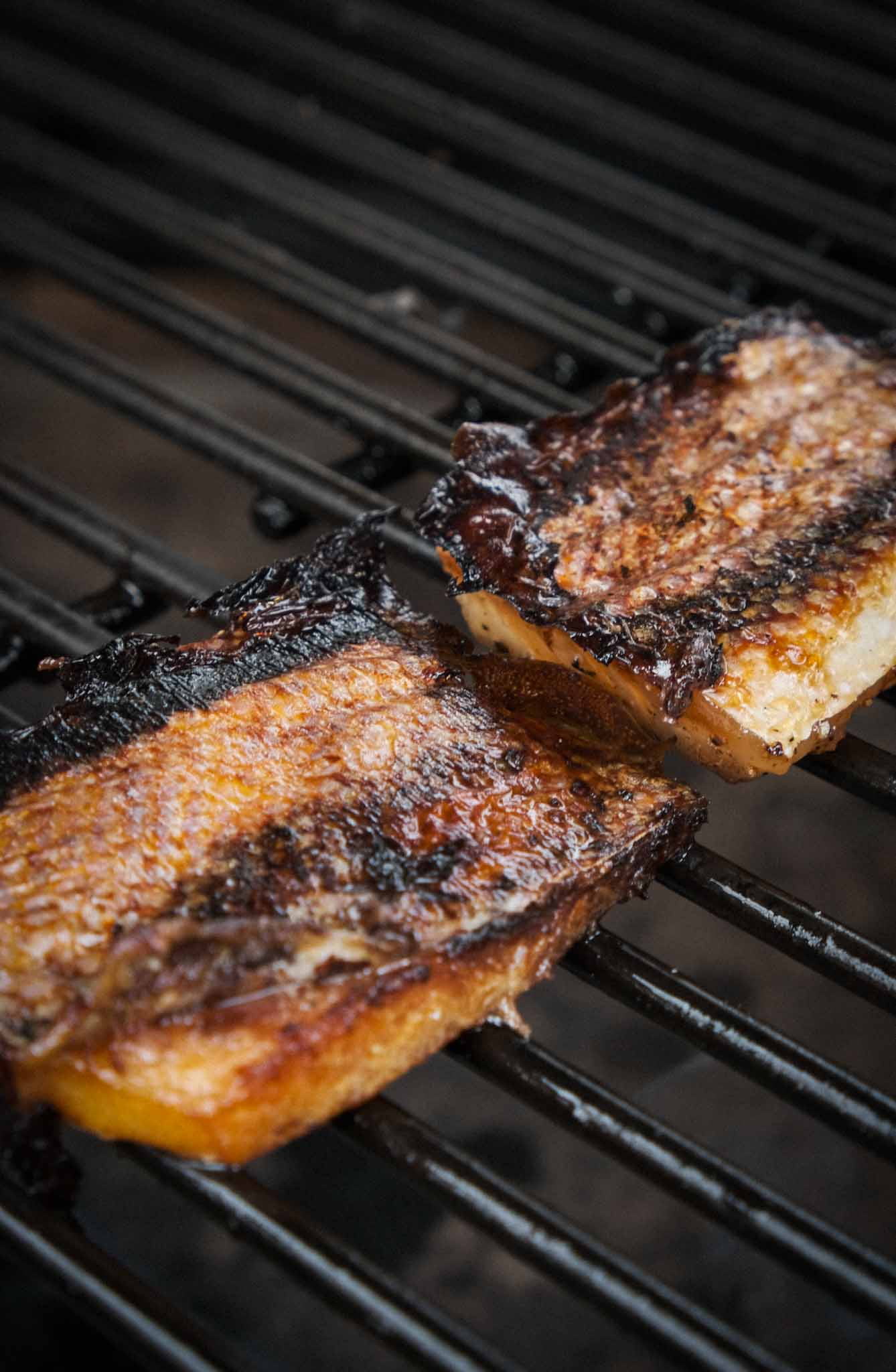
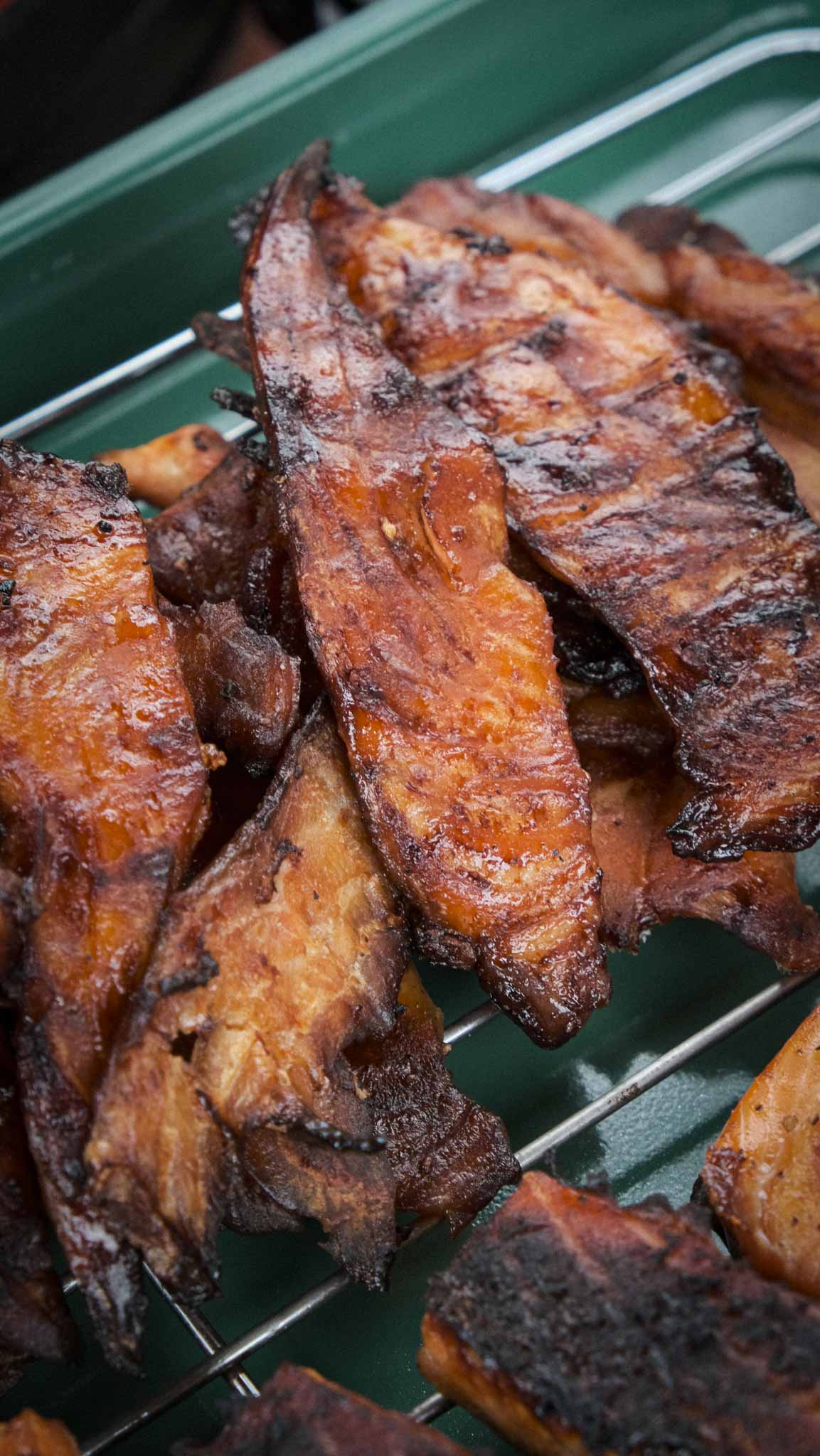
Try this smoked salmon dip (dairy-free but still creamy) that I made with some of the leftovers of this recipe!
Types of wood(chips) to use for smoking:
When it comes to smoking food, different species of wood impart unique flavors and aromas to the food being cooked. The choice of wood ultimately depends on personal preference and the type of food you are smoking. Here are some popular wood species that are commonly used for smoking:
- Mesquite: Mesquite wood offers a strong and distinct flavor. It is commonly used for grilling and smoking red meats like beef and pork. However, due to its strong flavor, it is recommended to use mesquite sparingly or in combination with other milder woods.
- Hickory: Hickory is one of the most popular smoking woods, particularly for meats. It provides a strong, sweet, and smoky flavor. Hickory is excellent for smoking pork, ribs, bacon, and other meats, adding a rich and robust taste.
- Apple: Applewood is known for its mild and slightly sweet flavor. It is versatile and goes well with a variety of foods, especially poultry, pork, and game birds. Applewood imparts a delicate smokiness without overpowering the natural flavors of the food.
- Cherry: Cherry wood offers a fruity and slightly sweet flavor that complements a range of meats, including poultry, pork, and beef. It adds a reddish color to the meat and creates a mild smokiness that is well-balanced.
- Oak: Oak is a reliable and widely available wood that provides a medium to strong smoky flavor. It is suitable for smoking a variety of meats, including beef, pork, and poultry. Oakwood burns slowly and can be used as the primary wood or in combination with other woods.
- Maple: Maple wood gives a subtle and sweet flavor to smoked food. It works well with pork, poultry, and vegetables. Maple imparts a mild smokiness and a hint of sweetness to the dishes.
Other popular options include pecan, alder, and peach wood, each with its own distinct characteristics. It’s worth experimenting with different wood species and combinations to discover the flavors you enjoy the most. Remember to use well-seasoned, dry wood to achieve the best results while smoking food.
Wild salmon vs farmed salmon:
There are some key differences between wild-caught and farm-raised salmon, and there is ongoing debate about which one may be better. Here are some of the differences:
- Nutrition: Wild-caught salmon tends to be leaner and contain fewer calories and saturated fats than farm-raised salmon. Wild salmon also tends to have higher levels of beneficial omega-3 fatty acids and vitamins and minerals. This is because wild salmon eat a natural diet and have more room to swim, whereas farm-raised salmon are often fed a processed diet and kept in crowded conditions.
- Contaminants: Farm-raised salmon may contain higher levels of contaminants, such as PCBs, dioxins, and antibiotics, than wild-caught salmon. This is because farm-raised salmon may be exposed to more pollutants in their environment or feed.
- Sustainability: Wild-caught salmon is generally considered more sustainable because it is caught in a way that does not harm the environment or deplete fish populations. In contrast, some farming practices can have negative impacts on the environment, such as polluting waterways or spreading diseases to wild fish populations.
In terms of which one is better, it really depends on your priorities. If you are looking for a leaner, more nutritious option, wild-caught salmon may be a better choice. If you are concerned about sustainability, wild-caught salmon is generally considered more environmentally friendly. However, if you are on a budget or prefer a milder flavor, farm-raised salmon may be a more practical choice. Regardless of which one you choose, both wild-caught and farm-raised salmon can be part of a healthy and balanced diet.
Alaskan versus Atlantic Salmon:
Atlantic salmon and Alaskan salmon differ in several ways, including their taste, nutritional content, and sustainability. Here are some key differences:
- Taste: Atlantic salmon has a milder, buttery flavor, while Alaskan salmon tends to be richer and more flavorful. The flavor of Alaskan salmon can vary depending on the species and where it was caught.
- Nutritional Content: Alaskan salmon tends to be leaner and have a firmer texture than Atlantic salmon. Alaskan salmon is also known for its high levels of beneficial omega-3 fatty acids, which can help lower the risk of heart disease and improve brain function. Atlantic salmon has slightly lower levels of omega-3s but is still a good source of protein and other essential nutrients.
- Sustainability: Alaskan salmon is considered one of the most sustainable types of salmon because of the strict regulations on fishing and the efforts to protect wild salmon populations. In contrast, Atlantic salmon is often farmed, and farming practices can have negative impacts on the environment, such as pollution and disease transmission.
In terms of which one is better, it really depends on your priorities. If you are looking for a sustainable option, Alaskan salmon is generally considered the better choice. If you prefer a milder flavor, Atlantic salmon may be a better option. However, both types of salmon are nutritious and can be part of a healthy diet. It’s also worth noting that the way the fish is cooked and prepared can also affect its nutritional value and taste.
Salmon nutrition | is smoked salmon good for you?
Salmon is a nutritious fish that is rich in protein, omega-3 fatty acids, and a variety of vitamins and minerals. Here are some of the nutritional facts and benefits of salmon:
Nutritional Facts:
- A 100-gram serving of salmon contains around 208 calories, 20 grams of protein, and 13 grams of fat, including healthy omega-3 fatty acids.
- Salmon is a good source of vitamin D, vitamin B12, and selenium, and also contains smaller amounts of other vitamins and minerals, including niacin, phosphorus, and potassium.
Smoked salmon nutrition benefits:
- Heart Health: The omega-3 fatty acids found in salmon can help lower blood pressure, reduce inflammation, and decrease the risk of heart disease and stroke.
- Brain Health: The same omega-3 fatty acids that benefit the heart also support brain health, helping to improve cognitive function, memory, and mood.
- Eye Health: The high levels of omega-3s found in salmon also promote eye health, reducing the risk of macular degeneration and other vision problems.
- Bone Health: The vitamin D and calcium found in salmon can help improve bone density and reduce the risk of osteoporosis.
- Inflammation Reduction: Salmon contains bioactive peptides that have been shown to reduce inflammation in the body, helping to prevent and alleviate various diseases.
Overall, salmon is a nutrient-dense food that can provide a wide range of health benefits.
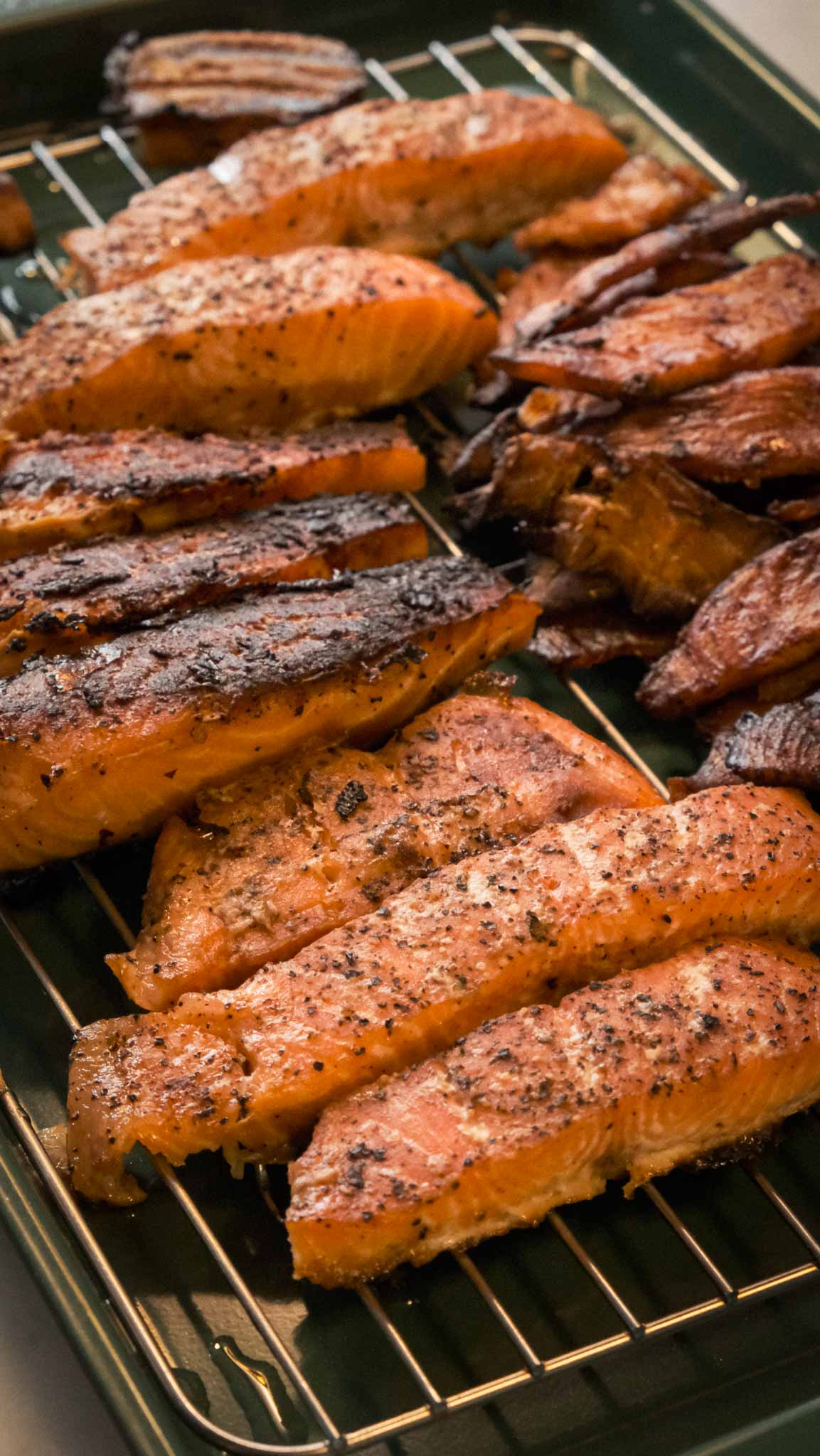
How to make hot smoked salmon
Equipment
- smoker (kamado Joe, big green egg, Traeger, are any charcoal smoker)
Ingredients
- Salmon
- Kosher Salt (no added agents such as anti-cracking)
- Brown Sugar
- Charcoal and damp wood chips (hickory, pecan, mesquite, oak, apple, maple, alder)
- Optional: Spice or herb rub. Maple syrup, spicy pepper hot sauce (for basting while cooking)
Instructions
- Forethought: Use as much fish as you would like, I use nearly 4 lbs because it is a long process and I like to get as much out of my time as I can. Keep skin intact on the fish.
- Making the brine: Add the brown sugar, kosher salt and water to a pot and boil until everything is completely dissolved. Allow to cool completely. Add the fish and place in the refrigerator for 12 hours.
- Prepare your smoker to 200-225°F with charcoal and dampened wood chips.
- Remove the fish, rinse and pat dry. Add the your smoker skin side down.
- Optional: baste the top of the fish throughout the cooking process with maple syrup or spicy pepper sauce or a mixture of both.
- Remove when the internal temperature has reached approximately 140°F. If you don’t have an internal temperature reading you can alway break open the center of one fillet to check it around 3 hours and sample it to tell if it is done.
Notes
If you like this smoked salmon side recipe, you may like my crispy chipotle salmon rice bowl recipe. Thank you for checking out this recipe for how to make hot smoked salmon, I hope you have fun with this process and enjoy!


